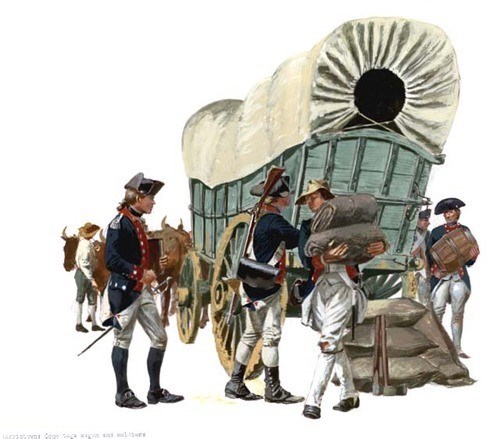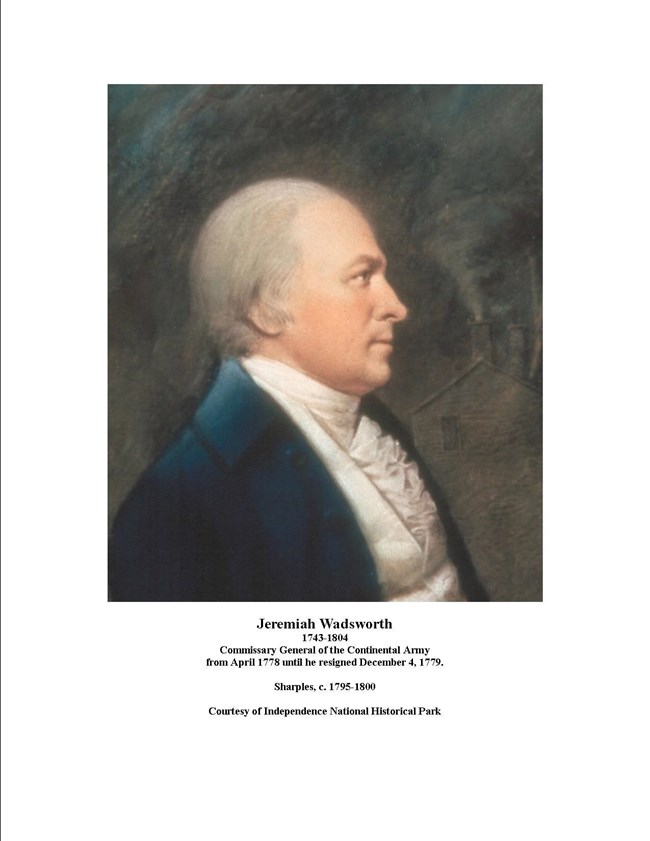Last updated: January 23, 2025
Article
The Commissary Department

The Commissary Department’s main task was to purchase, pack, and distribute rations of food and supplies to the Continental Army. At Valley Forge,especially at the beginning of the encampment, the Commissary Department's role was critical to the survival of the army.
“Full as I was in my representation of matters in the Commissary’s department yesterday, fresh and more powerful reasons oblige me to add, that I am now convinced beyond a doubt, that unless some great and capital change suddenly takes place in that line this Army must inevitably be reduced to one or other of these three things. Starve—dissolve—or disperse, in order to obtain subsistence in the best manner they can….”
- Letter from George Washington to the President of Congress Henry Laurens, December 23, 1777.
The Commissary Department was under the direct control of Congress, as opposed to the Quartermaster Department, which was under the control of the army. The commissaries would receive pay plus a commission on what they bought. There were commissaries to four military departments responsible for gathering supplies in their geographic locations: Eastern: (Connecticut, Rhode Island, Massachusetts, New Hampshire.) Northern (New York.) The Middle: (New Jersey, Pennsylvania, Delaware, and Maryland.) The Southern (Virginia, North Carolina, South Carolina, and Georgia.) The commissaries were divided into two groups: the Issuing Commissaries composed of civilians, often served with the troops and at military posts, making sure the soldiers received the goods; and the Purchasing Commissaries who circulated throughout the country handling the business of purchasing goods.
The Commissary General in charge of the Department during the Valley Forge encampment was William Buchanan. Buchanan was appointed by the Continental Congress on August 5, 1777.
Commissary Department Personnel, 1777-1778
Commissary General of Purchases
Joseph Trumbull, 6/18/77- 7/19/77
William Buchanan, 8/5/77- 3/20/78
Jeremiah Wadsworth, 4/9/78 – 1/1/80
Commissary General of Issues
Charles Stewart 6/18/77 – 1782
Deputy Commissaries of Purchases (In the Military Departments)
William Aylett (Southern) 6/18/77
Jacob Cuyler (Northern) 6/18/77
Ephraim Blaine (Middle) 8/6/77
Peter Colt (Eastern) 8/9/77
Deputy Commissaries of Issues (In the Military Departments)
William Green Mumford (Southern) 6/18/77
James Blicker (Northern) 8/6/77
Samuel Gray (Eastern) 8/6/77
Thomas Jones (Middle)
Rations
During the Valley Forge Encampment each soldier was to receive a daily ration of the following:
-
1 ½ pounds of Bread
-
1 pound of Beef or Fish or ¾ pounds of Pork
-
¼ pint of Whiskey or Spirits or 1-quart spruce or malt beer
-
½ pint of peas or beans
-
1 pint of milk
-
6 ounces of butter (per week)
-
½ pint of vinegar (per week)
-
1/6 pound of soap (per week)

Supply Challenges at Valley Forge
Throughout the Revolutionary War and especially at Valley Forge, the soldiers did not always get what they were promised.
Joseph Plumb Martin wrote upon his arrival at Valley Forge that,
“…I lay here two nights and one day and had not a morsel of anything to eat all the time, save half a small pumpkin…”
The Commissary Department struggled to gather the necessary foods and other goods that the soldiers required. The Commissary General William Buchanan spent most of his time and energy dealing with members of Congress in York, Pennsylvania. Buchanan would leave essential details of the department to his subordinates, and had little grasp on how much food was actually needed and consumed by the army.
From the General Return of Provision and Store Issued in Camp of December 1777 to February 1778, it was reported that the soldiers consumed more than 2,225,000 pounds of beef, 2,974,000 pounds of flour, and 500,000 gills of rum and whiskey. The states of New Jersey and Pennsylvania had limited spare food and forage for the army to acquire due to the previous military campaigns.
The worst of the supply crisis hit the encampment in early to mid-February of 1778. When the Committee from Congress visited the Valley Forge encampment, they called the prospects for provisions, “truly alarming.” The distance to transport and gather supplies, other troops in the states siphoning off supplies, inflation, and lack of cooperation made it extremely difficult to get the supplies the army needed. For example, there were three competing sets of commissary agents operating in Pennsylvania: the congressional commissioners, the Board of War procurement commissioners, and the state of Pennsylvania’s own supply commissioners.
In the spring of 1778, the supply situation was improving with the various purchasing agents successfully gathering an uninterrupted flow of food for the encampment. Newly-appointed Quartermaster General Nathanael Greene replaced William Buchanan who resigned in March with Jeremiah Wadsworth for the position of Commissary General of Purchases. Wadsworth worked with purchasing Agents, notably Ephrain Blaine of Pennsylvania, Deputy Commissary of Purchases of the Middle Department. Blaine was successful in gathering cattle from the most southern extremities of the Middle Department and ensuring that the droves reached Valley Forge. Food shortages would still occur throughout the war, but the placement of Wadsworth and Blaine would make these shortages few and far between.
Sources
Carp, E Wayne. “To Starve the Army at Pleasure: Continental Army Administration and American Political Culture, 1775-1783.” 1984.
Marshall, Joan. “The Other Side of the River”, Valley Forge Briefs No. 1, March 1983.
Martin, Joseph Plumb. “Ordinary Courage: The Revolutionary War Adventures of Joseph Plumb Martin.”
Risch, Erna. “Supplying Washington’s Army”, Center of Military History – United States Army, Washington, D.C., 1981.
Thibaut, Jacqueline. “Valley Forge Historical Research Report Volume II: This Fatal Crisis Logistics and the Continental Army at Valley Forge, 1777-1778.” Valley Forge National Historical Park, 1982.
